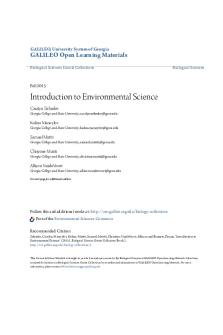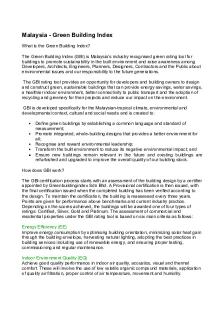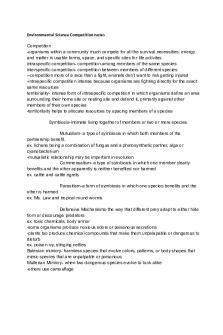Malaysia GBI environmental science PDF

| Title | Malaysia GBI environmental science |
|---|---|
| Author | Mohd Hasri |
| Course | Environmental Engineering & Sustainability |
| Institution | Universiti Teknologi MARA |
| Pages | 2 |
| File Size | 89.8 KB |
| File Type | |
| Total Downloads | 111 |
| Total Views | 178 |
Summary
Malaysia GBI environmental science for sustainability...
Description
Malaysia - Green Building Index What is the Green Building Index? The Green Building Index (GBI) is Malaysia’s industry recognised green rating tool for buildings to promote sustainability in the built environment and raise awareness among Developers, Architects, Engineers, Planners, Designers, Contractors and the Public about environmental issues and our responsibility to the future generations. The GBI rating tool provides an opportunity for developers and building owners to design and construct green, sustainable buildings that can provide energy savings, water savings, a healthier indoor environment, better connectivity to public transport and the adoption of recycling and greenery for their projects and reduce our impact on the environment. GBI is developed specifically for the Malaysian-tropical climate, environmental and developmental context, cultural and social needs and is created to: • Define green buildings by establishing a common language and standard of measurement; • Promote integrated, whole-building designs that provides a better environment for all; • Recognise and reward environmental leadership; • Transform the built environment to reduce its negative environmental impact; and Ensure new buildings remain relevant in the future and existing buildings are refurbished and upgraded to improve the overall quality of our building stock. How does GBI work? The GBI certification process starts with an assessment of the building design by a certifier appointed by Greenbuildingindex Sdn Bhd. A Provisional certification is then issued, with the final certification issued when the completed building has been verified according to the design. To maintain the certification, the building is reassessed every three years. Points are given for performance above benchmarks and current industry practice. Depending on the scores achieved, the buildings will be awarded one of four types of ratings: Certified, Silver, Gold and Platinum. The assessment of commercial and residential properties under the GBI rating tool is based on six main criteria as follows: Energy Efficiency (EE) Improve energy consumption by optimising building orientation, minimizing solar heat gain through the building envelope, harvesting natural lighting, adopting the best practices in building services including use of renewable energy, and ensuring proper testing, commissioning and regular maintenance. Indoor Environment Quality (EQ) Achieve good quality performance in indoor air quality, acoustics, visual and thermal comfort. These will involve the use of low volatile organic compound materials, application of quality air filtration, proper control of air temperature, movement and humidity.
Sustainable Site Planning & MANAGEMENT (SM) Selecting appropriate sites with planned access to public transportation, community services, open spaces and landscaping. Avoiding and conserving environmentally sensitive areas through the redevelopment of existing sites and brownfields. Implementing proper construction management, storm water management and reducing the strain on existing infrastructure capacity. Materials & Resources (MR) Promote the use of environment-friendly materials sourced from sustainable sources and recycling. Implement proper construction waste management with storage, collection and re-use of recyclables and construction formwork and waste. Water Efficiency (WE) Rainwater harvesting, water recycling and water-saving fittings. Innovation (IN) Innovative design and initiatives that meet the objectives of the GBI. For more information, refer to www.greenbuildingindex.org Which category do our sensors come under the GBI Critieria? CO2 sensor Energy Efficiency - Airconditioning System Indoor Environmental Quality CO sensor Energy Efficiency - Ventilation In Carpark Indoor Environmental Quality Occupancy sensor Energy Efficiency - Lighting...
Similar Free PDFs

Environmental Science
- 16 Pages

Environmental Science Module 1
- 4 Pages

Environmental Science and Engineering
- 109 Pages

GBI - Kapitelzusammenfassung
- 21 Pages

Environmental Science Midterm Review
- 17 Pages

Environmental Science Questions
- 52 Pages

Environmental Science Review Sheet
- 19 Pages

Environmental Science Lecture notes
- 25 Pages

Environmental Science English Only
- 10 Pages
Popular Institutions
- Tinajero National High School - Annex
- Politeknik Caltex Riau
- Yokohama City University
- SGT University
- University of Al-Qadisiyah
- Divine Word College of Vigan
- Techniek College Rotterdam
- Universidade de Santiago
- Universiti Teknologi MARA Cawangan Johor Kampus Pasir Gudang
- Poltekkes Kemenkes Yogyakarta
- Baguio City National High School
- Colegio san marcos
- preparatoria uno
- Centro de Bachillerato Tecnológico Industrial y de Servicios No. 107
- Dalian Maritime University
- Quang Trung Secondary School
- Colegio Tecnológico en Informática
- Corporación Regional de Educación Superior
- Grupo CEDVA
- Dar Al Uloom University
- Centro de Estudios Preuniversitarios de la Universidad Nacional de Ingeniería
- 上智大学
- Aakash International School, Nuna Majara
- San Felipe Neri Catholic School
- Kang Chiao International School - New Taipei City
- Misamis Occidental National High School
- Institución Educativa Escuela Normal Juan Ladrilleros
- Kolehiyo ng Pantukan
- Batanes State College
- Instituto Continental
- Sekolah Menengah Kejuruan Kesehatan Kaltara (Tarakan)
- Colegio de La Inmaculada Concepcion - Cebu






